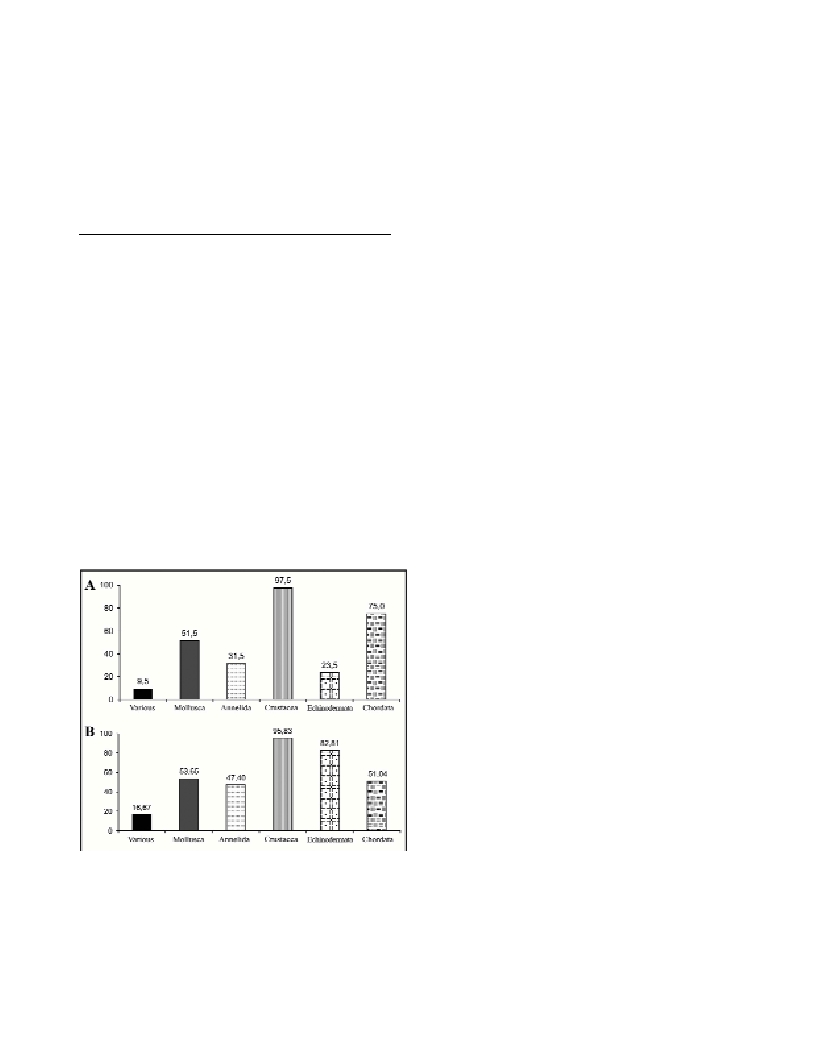DIET COMPARISON OF THE BATHYAL SHRIMPSARISTEOMORPHA FOLIACEA(RISSO, 1827)
AND ARISTEUS ANTENNATUS (RISSO, 1816) (DECAPODA: ARISTEIDAE)
IN THE EASTERN MEDITERRANEAN.
Chartosia N.
1
*, Kitsos M.-S.
1
, Karani I.
1
, Tzomos Th.
1
, Tselepides A.
2
, Koukouras A.
1
1
Department of Zoology, School of Biology, Aristoteleio University of Thessaloniki, Greece - * akoukour@bio.auth.gr
2
Institute of Marine Biology of Crete, Iraklio, Crete, Greece
Abstract
Stomach contents analysis of the bathyal shrimps Aristeomorpha foliaceaand Aristeus antennatus, collected by otter trawl in the Cretan
Sea, at depths of 623-627 m, revealed the presence of a wide variety of prey categories. Crustacea was the most abundant and frequent
prey category in both species. The diets of A. foliaceaand A. antennatusdo not differ significantly.
Key words: Diet, Aristeus antennatus, Aristeomorpha foliacea
Rapp. Comm. int. Mer Médit., 37,2004
332
Introduction
The information concerning the diet of Aristeomorpha foliacea
(Risso, 1827) and Aristeus antennatus(Risso, 1816) in the Mediter-
ranean is limited to studies carried out in the northwestern or central
Mediterranean (1-5).
The aim of this study is to document and compare the diet of these
species in the Eastern Mediterranean.
Material and methods
The material was collected with an otter trawl in the Cretan Sea in
February 2000, at depths 623-627 m. Analysis of the stomach contents
followed previously described methods (6).
Results and discussion
The stomach content analysis of 200 individuals of A. foliacea
showed that 37% were empty. The most abundant prey category was
Crustacea (50.23% of the prey items) followed by Chordata (20.54%).
The analysis of 192 stomachs of A. antennatusshowed that 39% of
them were empty. The most abundant prey category was Crustacea
(41.80%) followed by Echinodermata (18.88%).
The percentage frequency of occurrence (F %) for the two species
is given in Figure 1. The most frequent prey category was Crustacea,
both for A. foliacea(Fig.1A) and for A. antennatus(Fig.1B).
Fig. 1. The percentage frequency of occurrence (F %) of A.Aristeo-
morpha foliacea, B.Aristeus antennatus.
Concerning A. foliacea, our results agree with Bello au Pipitone
(5), while those of A. antennatus agree with those of Cartes (3).
The diet comparison of these two species does not show significant
differences between them.
References
1-Lagardère, J.-P., 1971. Research on the nutrition of shrimps from the
Moroccan continental shelf. Tethys, 3(3): 655-675.
2-Cartes, J.E., F. Sardà, 1989. Feeding ecology of the deep-water aristeid
crustacean Aristeus antennatus. Mar. Ecol. (Prog. Ser.),54(3): 229-238.
3-Cartes, J.E., 1994. In?uence of depth and season on the diet of the deep
water aristeid Aristeus antennatusalong the continental slope (400 to
2300m) in the Catalan Sea (western Mediterranean). Mar. Biol., Berlin,
Heidelberg, 120(4): 639-648.
4-Cartes, J.E., 1995. Diets of, and trophic resources exploited by bathyal
penaeoidean shrimps from the western Mediterranean. Mar. Freshwat.
Res.,46(6): 889-996.
5-Bello, G., C. Pipitone, 2002. Predation on cephalopods by the giant red
shrimp Aristaeomorpha foliacea. J. Mar. Biol. Assoc. U.K.,82(2): 213-
218.
6-Deniel, C., 1975. Régimes alimentaires d’Arnoglossus thoriKyle et
d’Arnoglossus imperialisRafinesque (Téléostéens-Bothidae) en la baie de
Douarnenez. Rev. Trav. Inst. Sci. Pêches marit.,39(1): 105-106.

